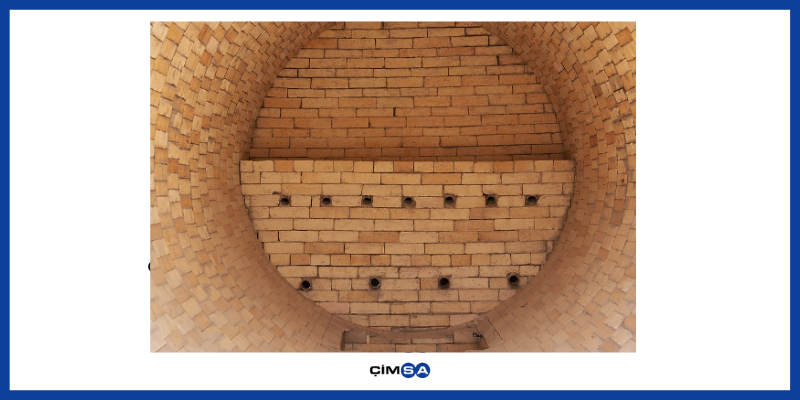Calcium aluminate cement can be preferred in field applications as an alternative to Portland cement. This is due to its distinct properties compared to Portland cement, depending on the intended use and performance requirements. The key difference between calcium aluminate cement and Portland cement lies in the distinct hydration products they form. This difference significantly affects the setting time and strength development behavior of the cement. Calcium aluminate cement has a much faster setting time and strength gaining property compared to Portland cement. In addition to its high early strength, it also exhibits excellent resistance to acids and high temperatures. Therefore, it can be used as a refractory material with high thermal resistance. We discussed what refractory is in the first article of our series — you can check it out in What Is Refractory? How To Use Calcium Aluminate Cement as Refractory? In this continuation of the series, we will focus on how calcium aluminate cement is used as a refractory material.
Using Calcium Aluminate Cement as Refractory
Calcium aluminate was discovered by Vicat in 1876. However, it began to be produced as cement in 1913 to reduce the effects of sulfate in concrete. In the following years, aluminate cement containing 40–80% alumina (Al₂O₃) began to be used in refractory applications. This is mainly due to alumina’s resistance to high temperatures. Depending on its alumina content, calcium aluminate cement allows the production of long-lasting and durable materials for refractory applications due to its high thermal resistance. Therefore, calcium aluminate cement provides reliable performance in specialized applications where Portland cement falls short. You can find more detailed information at our article titled Everything You Need To Know About Calcium Aluminate Cement.

Figure 1. Refractory Bricks
What Are the Reasons to Prefer Calcium Aluminate Cement as Refractory?
Concrete consists of cement paste, aggregates, and water. These components behave differently when exposed to high temperatures. Cement paste naturally expands as temperature increases, while the structure also shrinks due to the dehydration of hydrates. When expansion and shrinkage occur simultaneously, internal stresses develop within the structure. These stresses can lead to cracking.
Studies in the literature have shown that calcium silicate hydrates begin to partially vaporize at temperatures of 500 °C and above. Another study examined the behavior of calcium aluminate cement with 40% alumina content, compliant with the TS 6271 standard, when used in repair mortars. In this context, the effects of blending conventional Portland cement with calcium aluminate cement at various ratios in repair mortars were analyzed. You can find more information in our article titled Portland Cement and Setting Acceleration Mechanism.
These effects include changes in setting time, adhesion, and compressive strength. Experimental studies have yielded several findings. Substituting calcium aluminate cement can shorten setting times. Additionally, the rate of strength development increases. As a result, fast-setting and high-performance advanced repair mortars can be produced.
Wear resistance of concrete has also been evaluated in the literature. Although calcium aluminate cement is a relatively expensive material, its performance against abrasion and its resistance to acidic environments are quite high. Furthermore, experiments on thermal shock resistance and resistance to chemical and biological corrosion have shown that calcium aluminate cement may actually be more economical in many applications.
General Wear Mechanism of Refractory Materials and Considerations
The general wear mechanism of refractory materials is well defined in the literature. In this mechanism, raw materials, products, or byproducts penetrate the micropores of the refractory lining. These substances accumulate in the pores and, upon reaching a critical concentration, initiate melting at the surface. If the material contains a high-alumina additive or similar component, this transient liquid phase is absorbed by it. As a result, vitrification begins beneath the surface as the molten phase seeps downward.
This embrittled section eventually detaches from the main lining. The amount of material that melts, detaches, and wears away increases with rising temperature. Moreover, high porosity in the refractory lining contributes to this physical degradation. Porosity is expressed as a percentage of volume and is referred to as apparent porosity. Ideally, porosity should be kept as low as possible, since high temperatures trigger water loss in the porous structure. Increasing temperature also leads to the degradation of hydration products and the decomposition of the C-S-H (calcium silicate hydrate) structure.
Why Is Using Calcium Aluminate Cement as Refractory Important?
Calcium aluminate cement has a wide range of applications due to its unique properties. It offers high strength and rapid performance development for various intended uses. Moreover, it is frequently preferred in environments requiring high thermal and acid resistance, as it demonstrates excellent durability under such conditions.
Studies in the literature show that refractory concrete can be produced using different proportions of calcium aluminate cement. Ordinary Portland cement paste naturally expands as temperature increases. The combination of expansion and shrinkage within the structure leads to internal stresses, which in turn cause cracking and reduce the service life of the concrete.
Therefore, calcium aluminate cement is often preferred in applications where the performance of Portland cement is insufficient. Depending on its alumina content, calcium aluminate cement enables the production of long-lasting and durable materials for refractory applications due to its high thermal resistance.
In this article, we have addressed how calcium aluminate cement is used as a refractory material. In the next post in our series, we will explore the experimental studies conducted on the use of calcium aluminate cement as refractory and present their results.
References:
- Büyükçayır İ., ‘‘Çimento Sanayi Refrakterleri Aşınma Mekanizmaları ve Malzeme Seçimi ve İlgili Temel Kriterler’ Cement and Concrete World, No.37 , pp. 42-48, 2002.
- TS 6271 – Alüminalı Çimentolar- Refrakter Olarak Kullanılan, Türk Standartları Enstitüsü ,1988
- Scrivener K.L., Cabrion J.L., Letourneux R., ‘‘High-performance concretes from calcium aluminate cements’’ Cement and Concrete Research, Vol.29,pp.1215-1223, 1999



